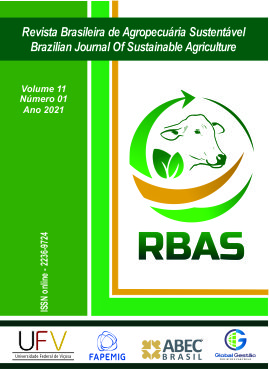Phytosociological survey of weeds in pineapple crops at different times
DOI:
https://doi.org/10.21206/rbas.v11i1.12723Keywords:
Ananas comosus, pineapple, phytosociology, weed plantsAbstract
Weeds are considered one of the most important factors that limit pineapple productivity. In this sense, the present work aimed to carry out the phytosociological survey of weeds present in two areas cultivated with pineapple, at different times (120, 240 and 360 days after planting - DAP). The species were identified according to the species, popular name and family. Then, they were calculated: frequency, relative frequency, density, relative density, abundance, relative abundance, importance value index, relative importance value index and the similarity index between areas (ISA) and epochs (ISE). In general, the species that most occurred were: Richardia brasiliensis, Urochloa decumbens, Digitaria sanguinalis, Euphorbia heterophylla and Cenchrus echinatus (area 1); Rottboellia cochinchinensis, Sida rhombifolia, Chamaesyce hirta and Amaranthus viridis (area 2). The ISA of the species found in the cultivated areas was 47.06%, with only eight species common to both areas. It was also evidenced that the phytosociological survey of weeds in a single area or time of year does not represent the potential for infestation of these areas when cultivated with pineapple.
Downloads
Downloads
Published
How to Cite
Issue
Section
License
Copyright (c) 2021 Brazilian Journal of Sustainable Agriculture

This work is licensed under a Creative Commons Attribution-NonCommercial-NoDerivatives 4.0 International License.
1. Proposta de Política para Periódicos de Acesso Livre
Autores que publicam nesta revista concordam com os seguintes termos:
Autores mantém os direitos autorais e concedem à revista o direito de primeira publicação, com o trabalho simultaneamente licenciado sob a Licença Creative Commons Attribution que permite o compartilhamento do trabalho com reconhecimento da autoria e publicação inicial nesta revista.











